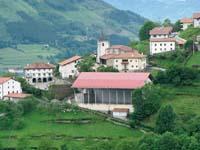Ecopopulation Orexa

Orexa is a small village located in the east of Gipuzkoa, in the middle of the mountain, of about 100 inhabitants, and it is possible that in the coming years its inhabitants will give energy lessons to others. In fact, the "Orexa: at the gates of a new era" project has been underway since June 2007.
The ultimate goal of the project is to boost energy efficiency. That is, consume as little energy as possible and, at the same time, produce in the municipality itself, as far as possible. To do this, an energy diagnosis will be made and then a series of measures will be proposed, some with considerable investment and others with very little money.
Diagnosis
The technical part of the project is being carried by the IEFPS Renewable Energy Center in Usurbil, through Xabier Esteban Alonso. He explained that the first work has been to know the current situation, so it proceeded to explain and diagnose the plan to the citizens.
They started from the town hall. Lighting, windows, toilets and fittings were mainly analyzed. The results were satisfactory, with numerous energy-saving bulbs and relatively new computers. The water installation is also clean. They have also seen that street lamps are quite new, so they will not propose change. It would be enough to supply renewable energy.
An individualized study is wanted in private homes. A comprehensive survey of household size, number of inhabitants and household energy and water consumption has been launched. Some conclusions have also been drawn.
As for lighting, for example, the power installed in old technologies is sufficient: 60% of the lighting in private homes is achieved with incandescent and halogen lamps; more than 80% of the energy consumption is lost in the form of heat.
In the water consumption section, 72% of households have dual-discharge equipment in the toilet, but only 26% of the taps have some type of flow regulator. A total of 178 consumer points have been counted. As for the windows of the buildings, most have wooden carpentry (91%) and double glass (76%).

On the other hand, among the positive results there is one that Xabier has highlighted especially: the usual temperature in households. Both in the polls and in their relationship with the citizens have been able to verify that the hot kitchen and the rest of the house remain fresh --17-20ºC -, 'in the old law'.
In the words of Xabier, there is a great habit of keeping houses at about 22-23º C in cities and walking at home with the empty nozzle, despite the winter. However, as they have seen in Orexa, kitchens do tend to be hot, but "they dress the jersey and have the house cooler, and that is a very energy-efficient custom; they are saving energy, although in many homes there is something new in terms of technology and insulation".
Finally, the survey also offered the opportunity to show our attitude towards renewable energy, and the response has been very good: most have responded that we would be willing to install renewable energy facilities both at home (roof or ground) and in the municipality.
Proposals
They must continue with the diagnosis, but with this data, those of the IEFPS are able to make the first proposals.
The installation of solar panels has been proposed at the municipal level and it is already approved the construction of a roof in the square and the placement of 117 m 2 panels in the ceiling. This is a 15 kW facility with an annual output of 17,000 kW/h. The investment is expected to be amortized in 14 years (with annual revenues of 7,400 e). However, "the economy, the money, is important, but philosophy is not a mere production, but we want to bring another value to the project."
At a particular level, changes in habits that can be made without spending money will be explained. And in the actions to be spent, they will specify the cost, the benefit or the savings. The first proposal will be to place low energy bulbs. Currently only 16% of households have this type of bulbs, but their extension to all of them means a reduction of up to five times the consumption of kW. In any case, it is not intended to replace conventional lamps with new ones. According to Xabier, it is surely not necessary to change all the bulbs. "Where it is used once a day and in a very short time, it is not worth making this investment, since the savings can be empty or insignificant."
However, it is estimated that water consumption can be considerably reduced to 50% by flow regulators.

Industry
Orexa has a single industry. It is a sheep cooperative, dedicated to cheese and curd, whose owners have also shown interest in the project.
The company has problems with serum and purine. Also with the temperature, since the sheep entering the pavilion in summer usually exceed 20ºC, so it is advisable to ventilate. Finally, fans used to dry grass balls also consume a lot of electrical energy.
From the IEFPS a series of proposals will be made that will help solve these problems, always in line with renewable energies and taking into account economic profitability. In the beginning, there are a couple of favorable factors: on the one hand, the pavilion has a roof of 700 m 2 and, on the other, the time of greatest energy need is summer, the time when you can obtain more energy from renewable sources. They are designed in photovoltaic, photothermal and geothermal energy.
The Orexa is a project that goes beyond the particular actions and that has been well received by the city council and citizens. And in those cases, there is no better incentive than to get good results gradually, both for the orexos and for the rest of those that can serve as an example. You can get lessons to learn!






